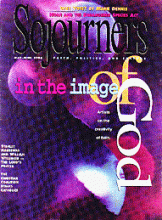She lays her smooth head in her mother's lap. Then she folds her long leg-long for a 9-year-old-under herself, hiding the pink satin ballet slipper on her foot. When I ask her, "How are you today, Chrissy?" she snuggles closer to her mother and remains mute.
Her picture hangs on the bulletin board by the nurses' station-an 8-by-10, black-and-white glossy, the sort that professional models use. In it, her hair cascades in curls, framing large eyes and a serious look. It was her publicity photo when she was on the circuit of beauty-and-talent pageants for little girls.
A recent newspaper clipping has been posted next to it. Its picture shows her in a bright red hat, with a big daisy on its floppy brim. She hugs a favorite doll and smiles broadly. The clipping, like all the articles I've seen on children surviving cancer, speaks of her courage, her indomitable spirit, her hope.
I have witnessed all those qualities in her-and in virtually all the children on the cancer ward of the children's hospital where I served as a chaplain. I watched her fly down the hall on her crutches after her leg was amputated and laugh heartily when a juggler came to visit the ward. But I am most grateful to be part of this moment-when she looks for all the world like a scared and delicate little bird with a broken wing, nestled in the protective embrace of its mother.
In my third week at the hospital, I walked into a room and an exhausted young mother thrust her crying 2-year-old into my arms. "Please, just take him," she pleaded as she untangled herself from his IV lines and left for a brief respite. I cradled Michael and rocked him to sleep and felt useful for the first time. Offering "presence" often seems like so little, and more than once I wished that I could juggle.
Read the Full Article
